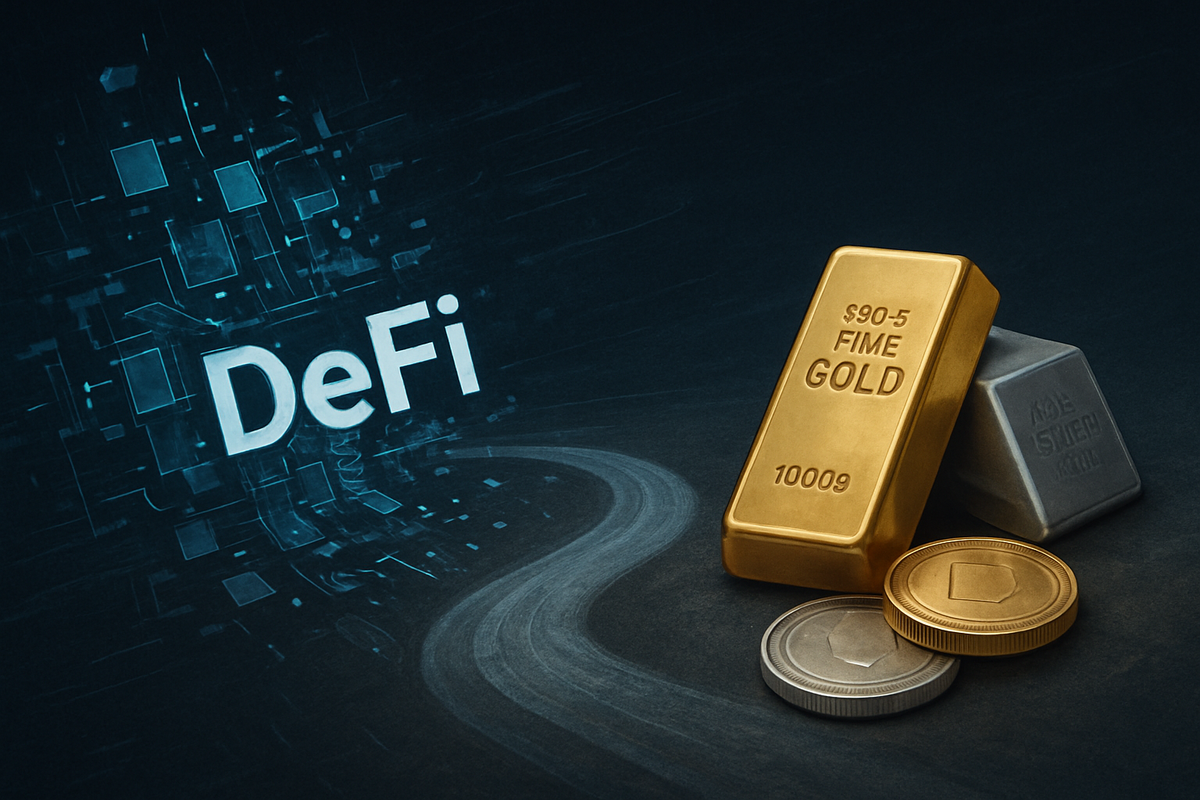
The Decentralized Finance (DeFi) market is currently navigating a period of profound instability as of November 2025, marked by a series of high-impact security breaches and a palpable erosion of investor confidence. Recent incidents, including a significant exploit on the Balancer protocol and the collapse of Stream Finance, have triggered a broad "risk-off" sentiment across the cryptocurrency ecosystem. This widespread market downturn is prompting a critical reevaluation of investment strategies, with many investors potentially seeking stability in traditional safe-haven assets such as gold and silver.
This article will delve into the specifics of these recent DeFi market upheavals, examining their immediate implications for digital asset valuations and investor behavior. We will explore the contrasting characteristics of digital and physical assets during times of market uncertainty and analyze whether the current volatility in the cryptocurrency market could indeed lead to a sustained shift towards more established stores of value, providing a comprehensive overview of the market's current state and future trajectory.
Unraveling the DeFi Market's Tumultuous November
The DeFi landscape has been severely rattled by several critical incidents leading up to and including November 2025, with billions in losses reported across the sector since late 2024. By mid-2025, over $2 billion in cryptocurrency had been stolen, with DeFi platforms experiencing a 44% rise in attacks. The cumulative effect of these losses has profoundly impacted investor sentiment.
The most recent and impactful event occurred in early November 2025, when the prominent decentralized exchange and automated portfolio manager, Balancer, suffered a catastrophic exploit. On Monday, November 3, 2025, attackers leveraged a sophisticated code exploit involving faulty access control mechanisms and a rounding-error vulnerability within Balancer's V2 Composable Stable Pools. This allowed them to drain between $116 million and $128 million in digital assets, including Wrapped Ethereum (WETH), StakeWise Staked ETH (osETH), and Lido's Wrapped Staked ETH (wstETH), across multiple blockchain networks like Ethereum, Polygon, and Base. This incident, impacting even forked projects such as Beets Finance and Velocore, underscored the persistent security challenges in DeFi, even for protocols that have undergone multiple audits.
Compounding the market's woes, the first week of November 2025 also witnessed a wave of DeFi-native stablecoins losing their dollar pegs. Stream Finance, a decentralized protocol, abruptly announced a suspension of all deposits and withdrawals on November 3, 2025, disclosing a staggering $93 million loss attributed to an external fund manager's liquidation during market turbulence in October. This caused its yield-backed stablecoin, xUSD, to plummet from its $1 peg to as low as $0.10. The crisis had cascading effects, freezing approximately $160 million in user funds and exposing the broader ecosystem to $285 million in systemic risk, directly impacting other protocols like Elixir, whose synthetic stablecoin deUSD crashed to $0.015. Additionally, Stable Labs' synthetic stablecoin, USDX, also plunged to $0.113 around November 7, 2025, potentially linked to forced liquidations triggered by the Balancer hack.
These incidents, coupled with earlier breaches like the Cetus Protocol exploit for over $200 million and the Garden Finance hack for $10.8 million, have led to a significant and unsettling sell-off across the broader cryptocurrency market. Bitcoin (BTC) plummeted below the psychologically critical $100,000 mark after reaching an all-time high of over $126,000 in early October, while other major altcoins like Ethereum (ETH) and Solana (SOL) also faced substantial losses. The Total Value Locked (TVL) in DeFi protocols experienced one of its steepest weekly contractions, falling from nearly $150 billion to $130 billion, indicating a significant slowdown in borrowing, lending, and staking activities and highlighting a clear "risk-off" sentiment dominating the market.
Winners and Losers in the Market Shake-Up
The recent DeFi market instability in late 2025 has created a clear division between potential winners and losers among public companies and entities. The "risk-off" environment in the crypto market has driven investors towards the perceived safety of traditional assets, with gold and silver being primary beneficiaries.
On the winning side, companies engaged in gold and silver mining and streaming are poised to benefit substantially from increased demand and price appreciation. Newmont Corporation (NYSE: NEM), the world's leading gold mining company, and Barrick Gold (NYSE: GOLD), a major gold producer, are expected to see strong financial performance. Agnico Eagle Mines (NYSE: AEM) is projected for substantial revenue and earnings growth for 2025. SSR Mining Inc. (NASDAQ: SSRM) has been a top performer in gold stocks, while Franco-Nevada (NYSE: FNV), a gold-focused streaming and royalty company, benefits from rising gold prices without direct operational risks. For silver, Fresnillo plc (LSE: FRES), the world's largest silver mining company, Pan American Silver Corp. (NASDAQ: PAAS), and First Majestic Silver (NYSE: AG) are well-positioned. Wheaton Precious Metals (NYSE: WPM), a streaming company, also stands to gain. Central banks globally, increasing their gold reserves to diversify away from the U.S. dollar and hedge against inflation, further underpin demand for these precious metals.
Conversely, companies and entities with significant direct exposure to the volatile DeFi ecosystem are likely to suffer losses and reputational damage. The affected DeFi protocols themselves, such as Balancer, Stream Finance, Elixir (deUSD), and Stable Labs (USDX), are the most direct losers, experiencing substantial financial losses, decreased Total Value Locked (TVL), and a severe erosion of user trust. Publicly traded companies with business models heavily reliant on highly volatile DeFi assets are also vulnerable. For instance, DeFi Development Corp. (NASDAQ: DFDV), with a treasury strategy focused on accumulating Solana (SOL) and engaging in DeFi opportunities, could be negatively impacted by a broader downturn in the altcoin market and speculative DeFi strategies. While specific major traditional financial institutions suffering direct losses from this particular DeFi downturn are not explicitly detailed, those with unhedged, speculative investments in volatile crypto assets or DeFi platforms could incur losses. Furthermore, crypto Exchange-Traded Funds (ETFs) and similar products have seen sustained outflows amidst macroeconomic pressures and DeFi challenges, impacting the profitability and assets under management of their issuers.
Broader Implications and Historical Parallels
The recent DeFi market turbulence represents a critical juncture for the industry, underscoring persistent vulnerabilities in smart contract security, the risks of interconnectedness, and the challenges of opaque "curator" models. This instability is accelerating a shift in investor sentiment towards traditional safe-haven assets like gold and silver, while also pushing the DeFi sector towards greater maturity through enhanced security, more robust risk management, and clearer regulatory frameworks.
This event fits into broader industry trends emphasizing enhanced security and risk management. The exploits highlight the critical need for rigorous audits, real-time monitoring, and on-chain anomaly detection beyond traditional code reviews. The industry is also witnessing a trend towards "smarter" and interconnected protocols, driven by real utility, automation, and seamless cross-chain access, with Artificial Intelligence (AI) increasingly integrated for market making, lending logic, and security. The tokenization of Real-World Assets (RWAs) is gaining significant momentum in 2025, with DeFi platforms incorporating tangible assets like real estate and stocks onto blockchain networks, expected to unlock new liquidity and grow to $16 trillion by 2030. Despite the turmoil, institutional adoption of crypto continues to accelerate, driven by regulatory clarity and the integration of digital assets by traditional finance (TradFi) giants.
The ripple effects of these losses are profound. The interconnectedness of DeFi protocols means that a failure in one can destabilize others, leading to liquidity contagion, as seen with the Stream Finance collapse affecting multiple counterparties and networks. Loss of confidence leads to mass withdrawals and a drop in TVL across various protocols, particularly impacting "risk curator" models that were popular in 2025 but proved vulnerable due to opaque strategies. This has also led to a shift towards fully transparent, regulated, or overcollateralized stablecoins. The competitive landscape might see centralized exchanges (CEXs) and more regulated entities gaining activity as investors seek safer alternatives.
From a regulatory standpoint, 2025 marks a turning point where DeFi regulation has transitioned from a fringe topic to a strategic global concern. New regulations, such as MiCA, DORA, and NIS2 in Europe, are placing greater emphasis on cybersecurity and operational resilience for DeFi projects, requiring robust risk management and prompt incident reporting. Regulators are also refining how digital assets are classified, distinguishing between truly decentralized protocols and "pseudo-decentralized" projects that may be treated as Crypto-asset Service Providers (CASPs). There are concerns that overly strict policies may stifle innovation, but the urgency for investor protection and preventing systemic risk is paramount.
Historically, the current DeFi market turbulence shares similarities with past financial crises and crypto market crashes. The collapse of the Terra ecosystem's algorithmic stablecoin UST in May 2022 is often referred to as a "Lehman moment" for DeFi, highlighting how a single point of failure can trigger widespread instability. Parallels are drawn to the dot-com bubble burst and the 2008 financial crisis, underscoring the need for tighter regulatory frameworks. These historical events remind investors of the cyclicality of market dynamics and the perils of rampant leverage and cascading liquidations, forcing the crypto industry to prioritize fundamental risk control and transparent governance.
The Road Ahead for DeFi and Traditional Assets
In the short term, the DeFi market is likely to experience continued volatility, potential further price declines, and decreased liquidity. There may be a sustained rotation of capital from altcoins to relatively "safer" crypto assets like Bitcoin or stablecoins, or even a complete exit from the crypto market for some investors. A heightened focus on cybersecurity and operational resilience is an immediate priority for DeFi projects to restore user trust.
Looking further ahead, the long-term outlook for DeFi is characterized by a push towards maturity, integration, and regulatory clarity. Regulatory evolution, with frameworks like the EU's Markets in Crypto-Assets Regulation (MiCA) fully effective, aims to provide clarity around licensing, taxation, AML measures, user protection, and smart contract security. This increasing compliance is crucial for attracting institutional capital, as 86% of institutional investors either hold or plan to invest in digital assets by 2025. The tokenization of Real-World Assets (RWAs) is identified as a major catalyst for bridging traditional finance (TradFi) and DeFi, attracting a broader investor base and institutional engagement, with the RWA market surging over 260% in the first half of 2025. Technological advancements in cross-chain interoperability, AI integration for automated strategies and risk assessment, and modular blockchain architectures will also drive future growth.
Strategic pivots for DeFi projects will include enhanced security measures, proactive regulatory engagement to align with evolving global frameworks, and a stronger focus on real-world utility through RWA tokenization. Comprehensive user education and investment in resilient infrastructure will also be crucial. Market opportunities include significant institutional capital inflow as regulatory clarity improves, continued growth of the RWA market, and innovation in AI and cross-chain solutions. Challenges persist, such as ongoing security risks, regulatory ambiguity, complexity for users, systemic risk, and inherent market volatility. Potential scenarios range from a fully regulated integration of DeFi into the global financial system, to a hybrid system where blockchain works alongside traditional institutions, or even a scenario where DeFi remains a niche, high-risk market if vulnerabilities persist. A sustained shift to safe havens like gold and silver is also possible in a prolonged period of crypto market instability.
Navigating a Transformed Financial Landscape
The recent turbulence in the Decentralized Finance market, particularly in late 2025, has served as a critical stress test, exposing both the immense potential and inherent risks of this rapidly evolving sector. The high-profile exploits of protocols like Balancer and the systemic issues leading to the collapse of Stream Finance and subsequent stablecoin depeggings have underscored the persistent vulnerabilities in smart contract security and the profound contagion risks inherent in interconnected DeFi ecosystems. These events, coupled with broader macroeconomic headwinds, have triggered a significant "risk-off" sentiment, prompting investors to reallocate capital from volatile digital assets towards the perceived stability of traditional safe-haven assets.
The key takeaways from this period are clear: robust security, transparent risk management, and regulatory clarity are no longer optional but essential for the long-term viability of DeFi. The market's increased sensitivity to global macroeconomic factors, such as central bank policies and the strength of the U.S. dollar, further blurs the lines between digital and traditional finance. As investors seek refuge, gold and silver have seen significant price surges, reaffirming their historical role as hedges against uncertainty, while even Bitcoin is being re-evaluated as a digital safe haven by some.
Moving forward, the DeFi market is on a path towards greater maturity and integration, despite short-term challenges. Projections indicate continued growth in transaction volume and Total Value Locked, driven by institutional adoption, the tokenization of Real-World Assets, and advancements in AI and cross-chain solutions. The lasting impact of these events will be a stronger emphasis on robust security measures, improved risk management frameworks, and clearer regulatory guidelines globally. This period could ultimately lead to a more resilient, transparent, and perhaps less "wild" decentralized financial ecosystem, better equipped to integrate with traditional finance.
Investors should closely watch several key indicators in the coming months. Prioritize protocols demonstrating robust security audits and transparent risk management strategies. Monitor global regulatory developments, as clearer frameworks will be crucial for attracting institutional capital. Keep a keen eye on macroeconomic indicators like interest rates and inflation, which will continue to influence both crypto and traditional asset markets. The growth of Real-World Asset tokenization will be a significant trend to follow, as will the stability of prominent stablecoins and the overall Total Value Locked across major DeFi protocols. Finally, observe Bitcoin ETF flows and the sustained performance of gold and silver as indicators of broader market sentiment towards risk and traditional safe havens. While the DeFi market faces ongoing challenges, its underlying trends suggest a dynamic future that requires informed and cautious participation.
This content is intended for informational purposes only and is not financial advice







